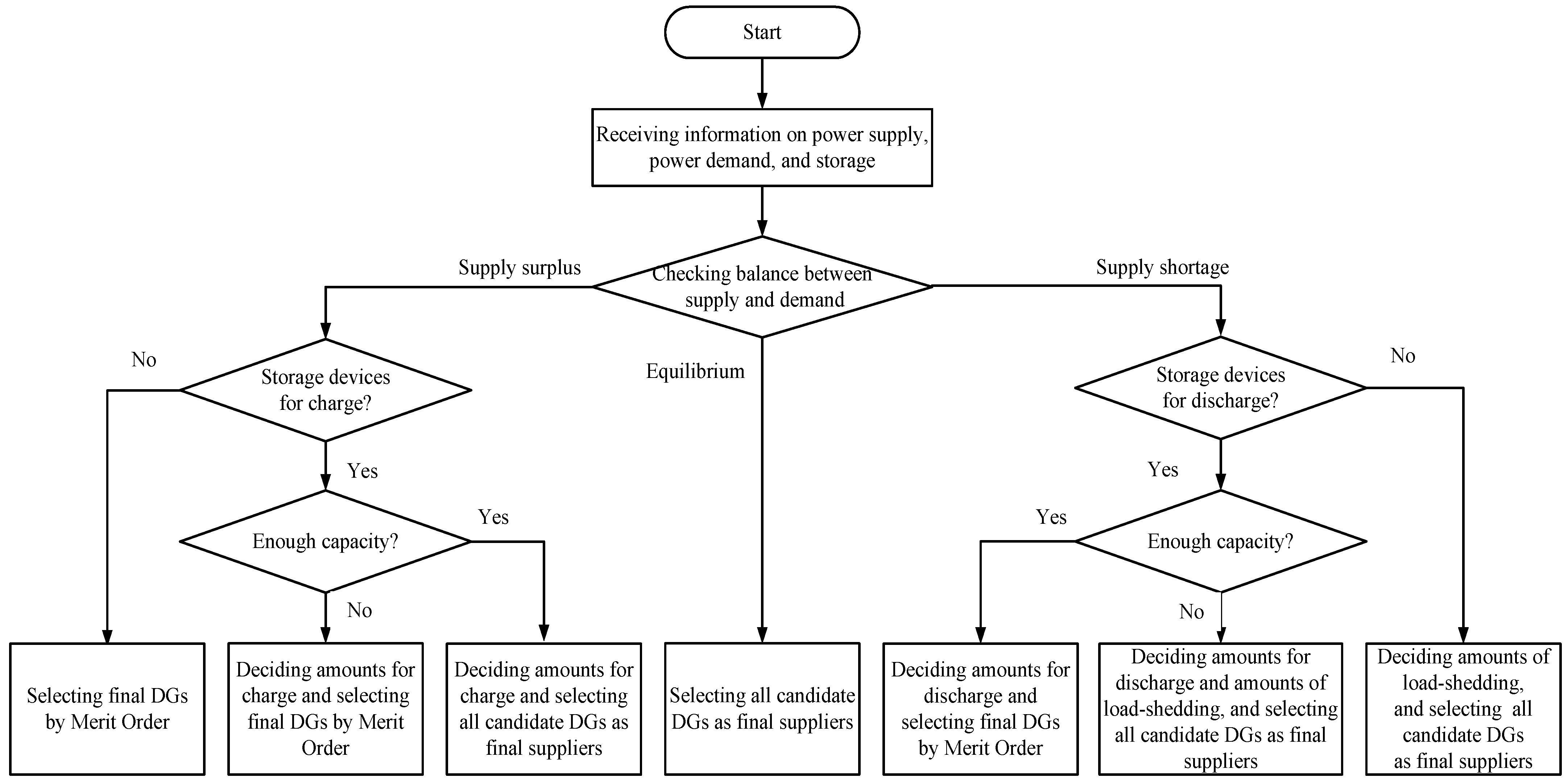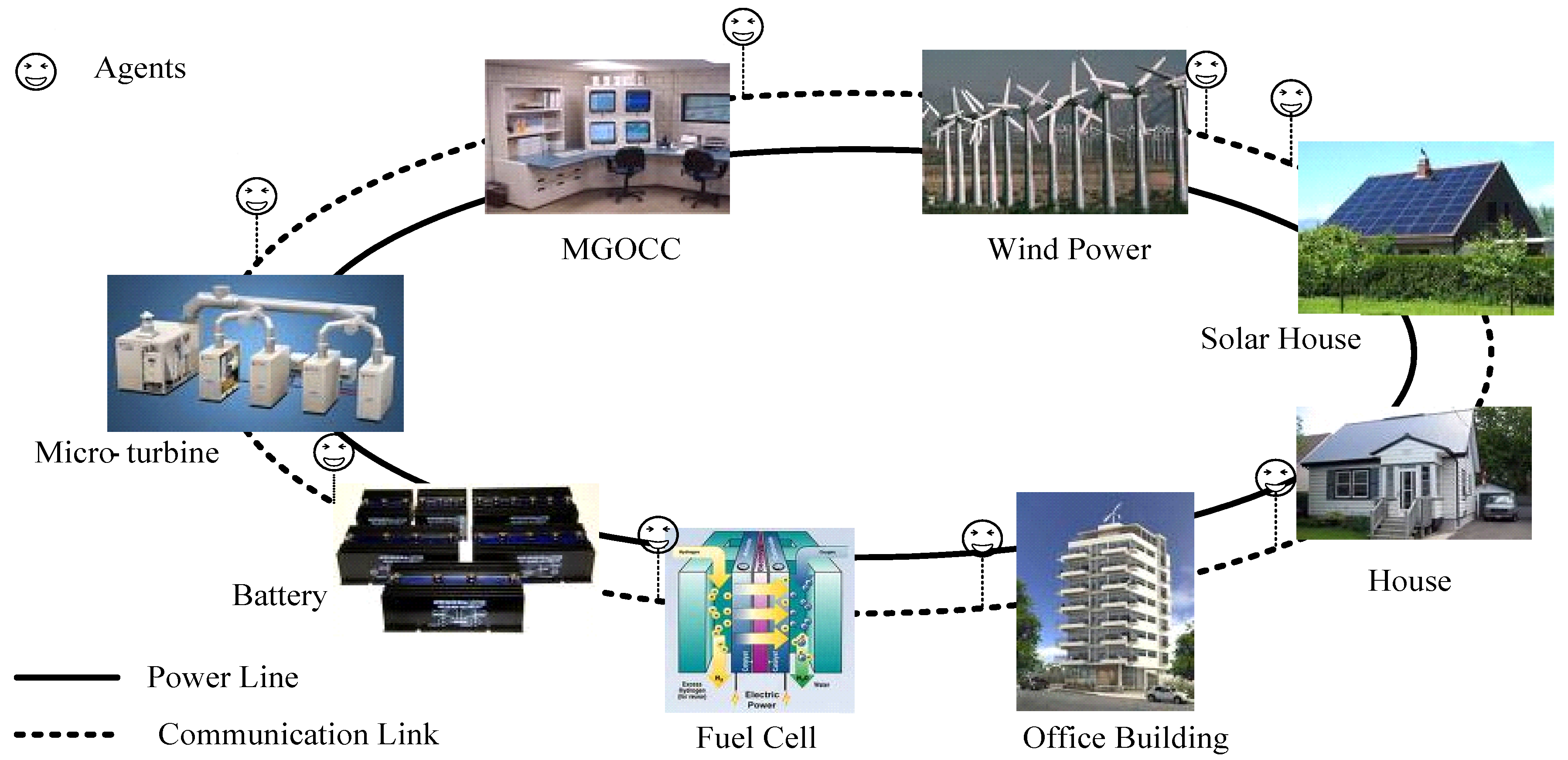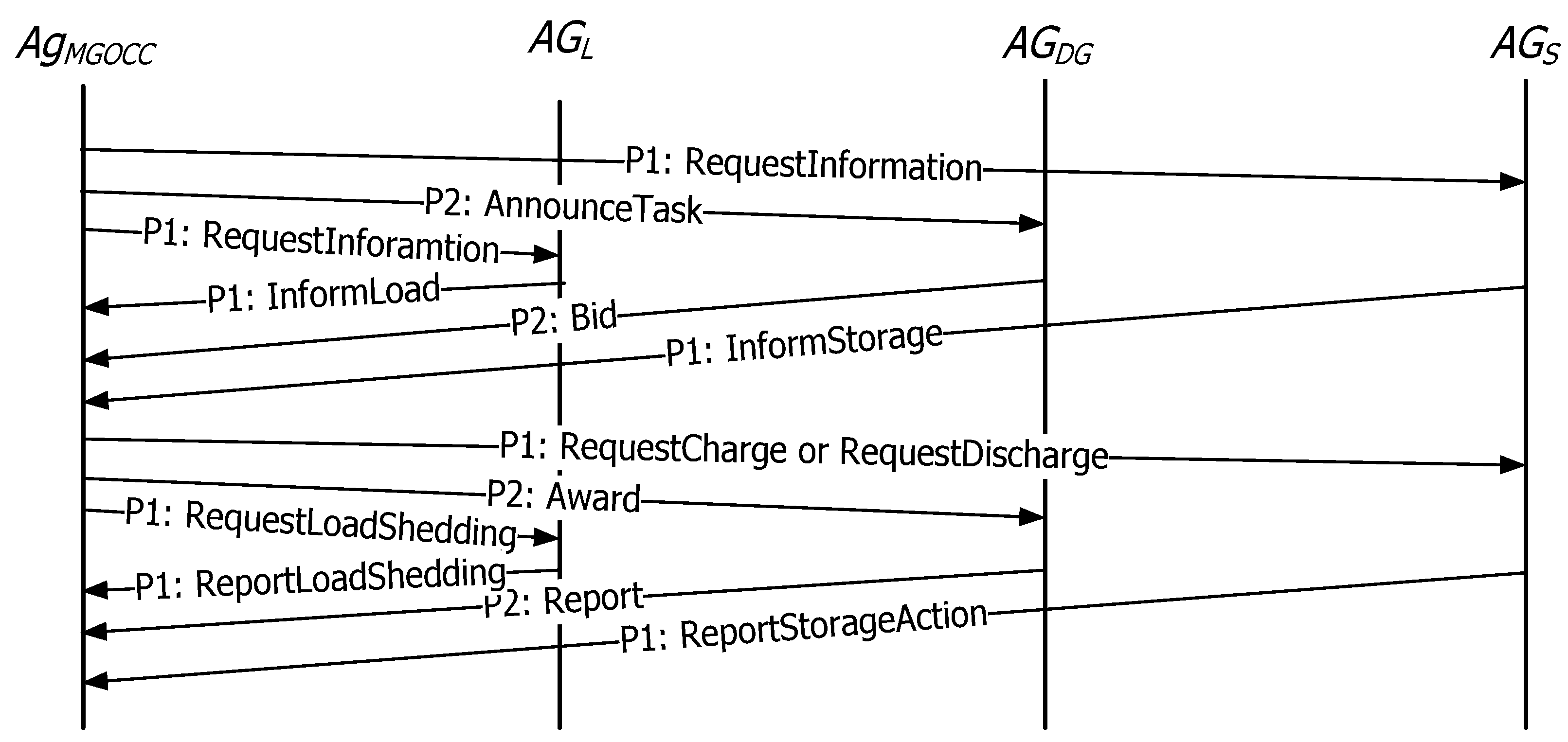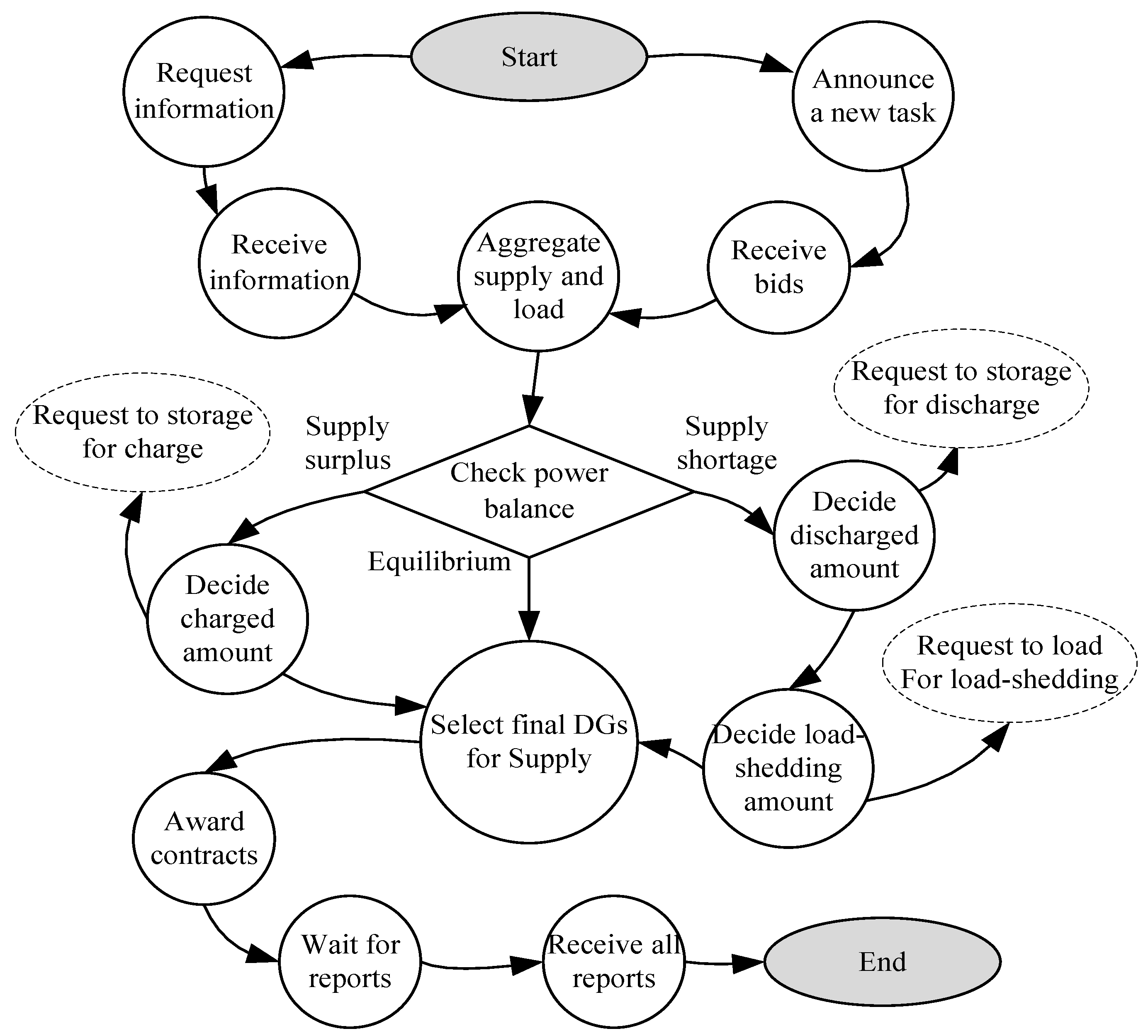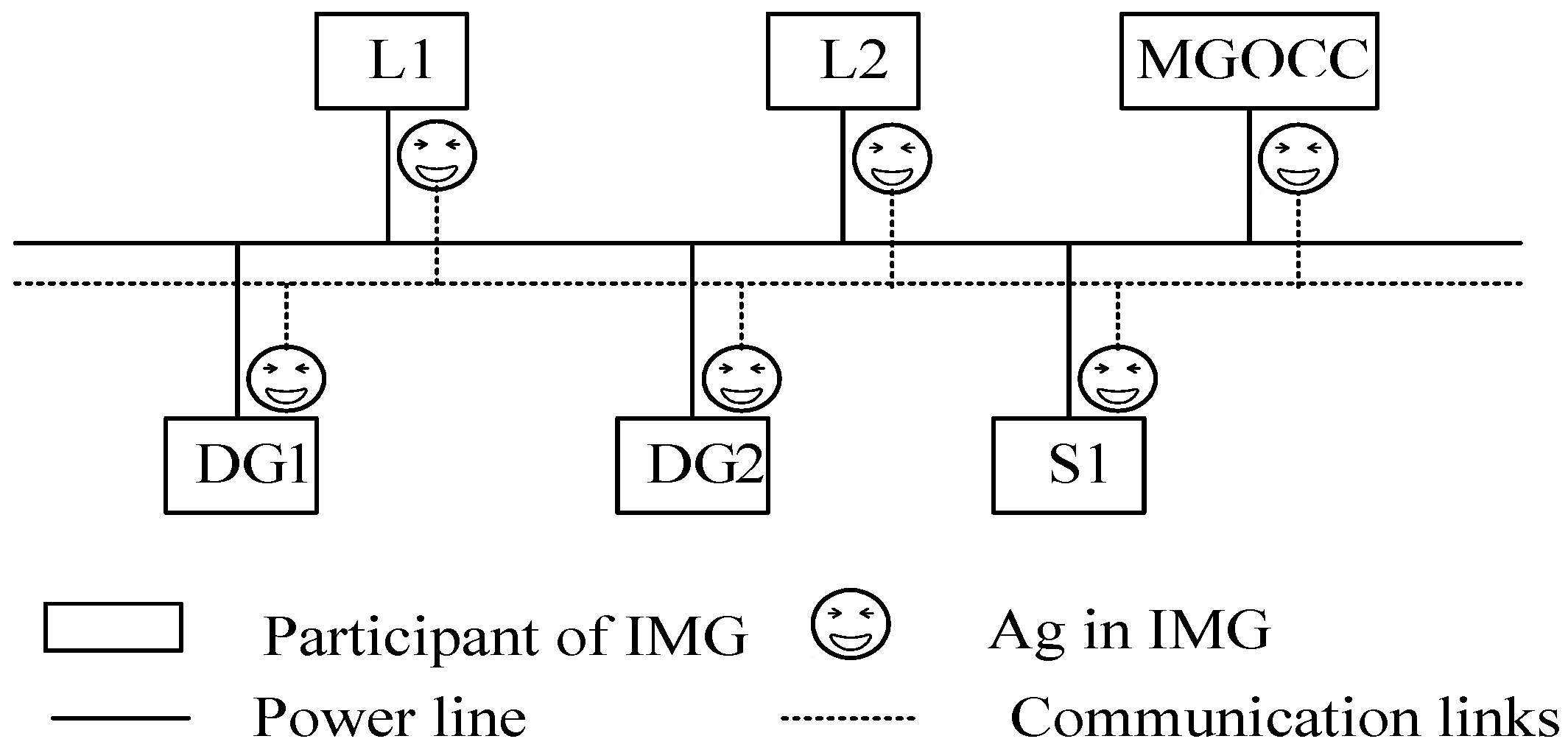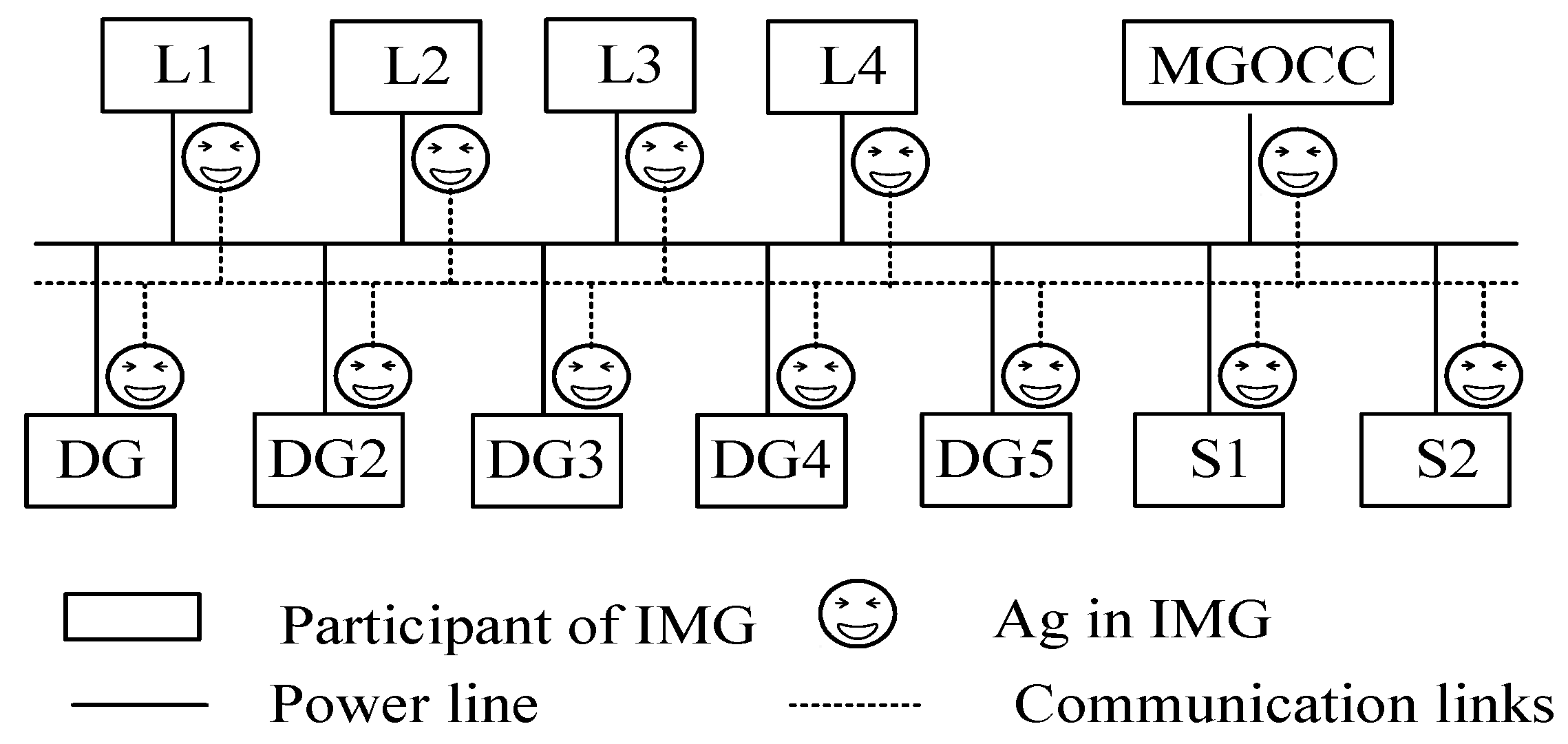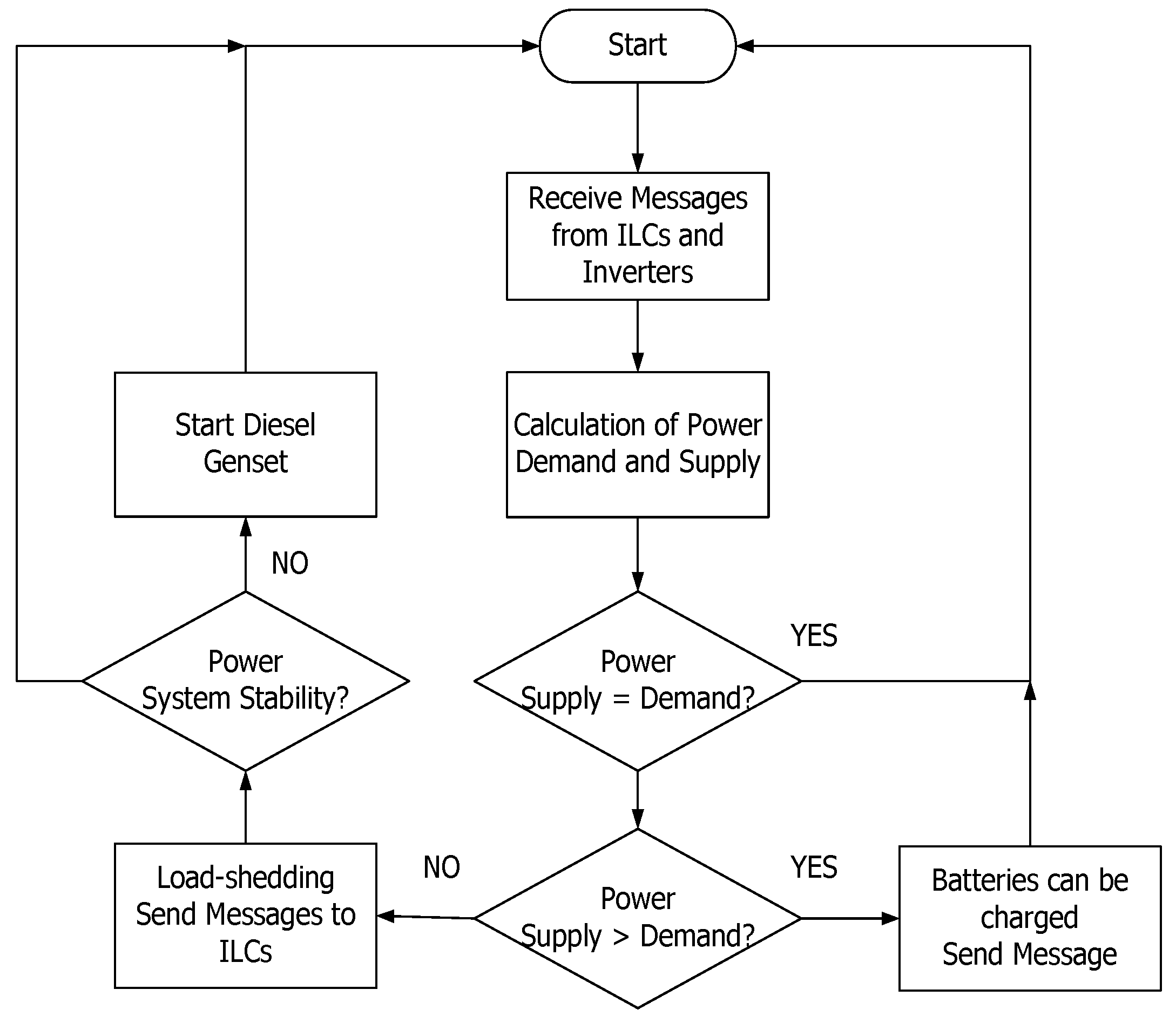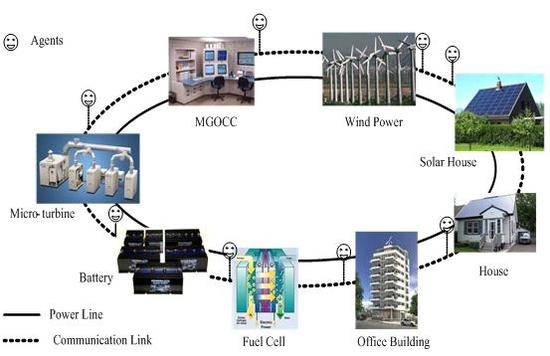1. Introduction
Recently, interest in microgrids with clean power sources such as wind power and solar power has been growing as a new eco-friendly energy system and the microgrid technology has been studied in many countries [
1,
2].
Electrical and thermal energies are produced in the microgrid but in this paper we focus on power. A microgrid can be operated in a grid-connected mode and an islanded mode. An islanded microgrid means a microgrid disconnected from any power grids by the occurrence of a fault in the interconnected power grid or by geographical isolation, such as on an island. One of the most important requirements of microgrid operation is to maintain a constant frequency such as 50 Hz or 60 Hz, which is closely related to a balance between power supply and power demand. Whenever a power imbalance in the islanded mode occurs, it should be solved by a decrease in generation in the case of supply surplus and load-shedding, which is an intentional reduction of load amounts, in the case of supply shortage. The power imbalance restricts the electricity use of consumers in the case of supply shortage and the power supply of suppliers in the case of supply surplus. Therefore, the islanded microgrid should be operated to reduce the power imbalance.
Attention on autonomous power grids has been growing in power engineering circles in recent years. To implement autonomous systems, multiagent system technology has been studied as a candidate technology in various areas [
3,
4,
5,
6,
7,
8,
9,
10]. Against this backdrop, multiagent systems for control and operation of the microgrid have been studied [
11,
12,
13,
14,
15,
16,
17,
18]. Automatic and autonomous operation and control of microgrids based on multiagent systems instead of human operators have some merits for efficient management because microgrids are small-scale power systems and the employment of skillful operators for their components is costly considering the size of the components. Recently, a multiagent system has been developed for the pilot microgrid of Kythnos Island (Greece) [
12]. The multiagent system dealt with the intelligent control of the pilot microgrid and showed the feasibility of the application of a multiagent system in a real microgrid.
In this paper, we propose a multiagent system for autonomous operation for an islanded microgrid in a power market environment. In general power systems, operation is planned in the previous interval and the established plan is implemented in the next interval. Components of the power system are controlled according to the established plan. Therefore, operation deals with a longer period than control. Islanded microgrid operation is a special challenge because of some uncertain factors such as stable output control of solar and wind power systems, accurate load forecasting, and load management according to an established plan. Recently, control and forecasting studies related to the uncertain factors have been studied [
12,
19,
20]. We focus on autonomous operation related to operation planning of an islanded microgrid based on a multiagent system and assume that the uncertain factors can be solved. In this respect, our paper has a different approach from the multiagent system for the pilot microgrid of Kythnos Island [
12]. In addition, we consider a competition environment among power suppliers. We establish a cooperative operation scheme for islanded microgrids on a power market environment to reduce power imbalance conditions as a common goal of all participants of the islanded microgrid. The cooperative operation includes an effective choice of storage devices between charge and discharge by announcing the information of a power balance between generation sources and loads. The merit order algorithm is used to decide final suppliers, which is a simple but practical algorithm selecting suppliers by descending order of their bidding prices [
17]. We use the Contract Net Protocol (CNP) [
21] for the bidding process of suppliers and an information exchange protocol (IEP) for other process among some agents such storage device agents and load agents. For load-shedding in the case of supply shortage, we apply the constrained equal losses (CEL) rule to load-shedding. The CEL is a well-known rule used in the bankruptcy problem dealing with the division of an insufficient estate among claimants [
22]. The proposed multiagent system is built on the ADIPS/DASH framework [
23,
24], which is a repository-based multiagent framework and tested on several operation conditions to show the feasibility and functionality of the proposed multiagent system. The contributions of this paper can be summarized as follows:
We consider a competition environment among power suppliers for microgrid operation.
We establish a cooperative operation scheme for islanded microgrids to reduce power imbalance conditions as a common goal of all participants of the islanded microgrid.
We use the CNP and design an IEP for interactions among agents for islanded microgrid operation.
The load-shedding scheme based on the CEL is applied to solve supply shortages of the islanded microgrid.
The proposed multiagent system is built on the ADIPS/DASH framework supplying various convenient functions for building multiagent systems.
We verify the feasibility of the proposed multiagent system for autonomous islanded microgrid operation through various condition tests.
In
Section 2, backgrounds relating to islanded microgrid operation such as concepts of microgrids and islanded operation. The proposed cooperative scheme and a load-shedding scheme based on the bankruptcy problem are explained in detail in
Section 3. In
Section 4, a multiagent system for microgrid operation is designed and constructed for tests. Various condition tests are performed to verify the functionality and feasibility of the proposed the multiagent system for islanded microgrid operation in
Section 5. In
Section 6, we provide our conclusions.
5. Experiment
To show the functionality and feasibility of the suggested multiagent system for islanded microgrid operation by the following operation conditions: supply surplus, supply surplus required the decrease in generation, supply shortage, and supply shortage required load-shedding as shown in Cases 1–4.
Figure 8 shows a multiagent-based islanded microgrid for Cases 1–4 and the multiagent system is composed of six agents: an MGOCC agent (
AgMGOCC), two DG agents (
AgDG1,
AgDG2), a DS agent (
AgS1), and two load agents (
AgL1,
AgL2). IMG means the islanded microgrid in
Figure 8.
Table 4 shows operation conditions, loads forecasted by load agents and information of a storage device. Here, Char and Aval mean the current charged amount and additionally available charging amount of the storage device, respectively.
Table 5 shows production costs and capacities of two DGs. We assume DGs bid their production costs as bid prices for simplicity.
We carry out additional tests with a more complex islanded microgrid shown in
Figure 9. The multiagent system is composed of 12 agents: an MGOCC agent (
AgMGOCC), five DG agents (
AgDG1,
AgDG2,
AgDG3,
AgDG4,
AgDG5), two storage device agents (
AgS1,
AgS2), and four load agents (
AgL1,
AgL2,
AgL3,
AgL4).
Figure 8.
Configuration of agent-based islanded microgrid for Cases 1–4.
Figure 8.
Configuration of agent-based islanded microgrid for Cases 1–4.
Table 4.
Operation condition of Cases 1–4.
Table 4.
Operation condition of Cases 1–4.
| Case | Condition | Load (kWh) | Storage (kWh) |
|---|
| 1 | Supply surplus | L1: 100 | L2: 96 | Char: 6 | Aval: 4 |
| 2 | Supply surplus | L1: 96 | L2: 96 | Char: 6 | Aval: 4 |
| 3 | Supply shortage | L1: 100 | L2: 104 | Char: 6 | Aval: 4 |
| 4 | Supply shortage | L1: 104 | L2: 104 | Char:6 | Aval: 4 |
Table 5.
DG information of Cases 1–4.
Table 5.
DG information of Cases 1–4.
| DG | Production Cost (¢/ kWh) | Capacity (kWh) |
|---|
| DG1 | 70 | 100 |
| DG2 | 80 | 100 |
Figure 9.
Configuration of agent-based islanded microgrid for Cases 5–6.
Figure 9.
Configuration of agent-based islanded microgrid for Cases 5–6.
Table 6.
Operation condition of Cases 5–6.
Table 6.
Operation condition of Cases 5–6.
| Case | Condition | Load (kWh) | Storage (kWh) |
|---|
| 5 | Supply surplus | L1: 70 L2: 75 | L3: 75 L4: 70 | S1: Char: 6 | Aval: 4 |
| 6 | Supply shortage | L1: 100 L2: 110 | L3: 105 L4: 102 | S2: Char: 3 | Aval: 2 |
In this experiment, we consider two operation conditions: supply surplus requiring a decrease in generation, and supply shortage requiring load-shedding in Cases 5–6.
Table 6 shows operation conditions, forecasted loads by load agents and information of storage devices and
Table 7 shows production costs and capacities of five DGs, respectively.
Table 7.
DG information of Cases 5–6.
Table 7.
DG information of Cases 5–6.
| DG | Production Cost (¢/kWh) | Capacity (kWh) |
|---|
| DG1 | 20 | 50 |
| DG2 | 50 | 50 |
| DG3 | 60 | 100 |
| DG4 | 70 | 120 |
| DG5 | 80 | 80 |
5.1. Case 1—Operation of Supply Surplus
A supply surplus of 4 kW occurs in this case. To meet the power balance for operation of the next interval, the supply surplus should be solved. In this case, we check whether our multiagent system can solve the supply surplus by charge action of a storage device.
Figure 10A displayed by MGOCC agent shows the result of Case 1. From the result, we can see that charge of S1 (4 kWh) is decided to solve the supply surplus.
5.2. Case 2—Operation of Supply Surplus Required Additional Decrease of Generation
A supply surplus of 8 kW occurs in this case. To meet the power balance between supply and demand for operation of the next interval, the supply surplus should be solved. We check whether charge of a storage device and the decrease of DGs are reasonably decided to solve the supply surplus.
Figure 10B shows the result of Case 2. From the result, we can see that charge action of S1 (4 kWh) is decided to solve the supply surplus. Also, the decrease of generation of DG2 (4 kWh) is additionally selected by the merit order algorithm.
5.3. Case 3—Operation of Supply Shortage
A supply shortage of 4 kW occurs in this case. To meet the power balance for operation of the next interval, the supply shortage should be solved. In this case, we check whether discharge of a storage device is decided to solve the supply shortage.
Figure 10C explains the result of Case 3. This result shows discharge of S1 (6 kWh) and the decrease of generation of DG2 (2 kWh) are decided for this operation condition. This result shows that discharge action of the storage device has a higher priority than the decrease of generation. The priority is decided by problem solving flow of the MGOCC agent shown in
Figure 7.
5.4. Case 4—Operation of Supply Shortage Required Load-shedding
A supply shortage of 8 kW occurs in this case. To meet the power balance between supply and demand for operation of the next interval, the supply shortage should be solved. In this case, we check whether discharge of a storage device and additional load-shedding are effectively decided to solve the supply shortage.
The result of Case 4 as shown in
Figure 10D illustrates that discharge of S1 (6 kWh), load-shedding of L1 (1 kWh), and load-shedding of by L2 (1 kWh) are decided to solve the supply shortage as expected.
Figure 10.
Result of (A) Case 1; (B) Case 2; (C) Case 3; (D) Case 4.
Figure 10.
Result of (A) Case 1; (B) Case 2; (C) Case 3; (D) Case 4.
5.5. Case 5—Operation of Supply Surplus Required Additional Decrease of Generation
A supply surplus of 110 kW occurs in this case. To meet the power balance between supply and demand for operation of the next interval, the supply surplus should be solved. We check whether charge of a storage device and the decrease of DGs are reasonably decided to solve the supply surplus.
Figure 11A shows the result of Case 5. As you can see the result, DG 5 is not selected as a final supplier because of its high bidding price and the output of DG 4 is reduced. The result of DGs shows that the merit order works well. Also, storage devices, S1 and S2, are fully charged.
5.6. Case 6—Operation of Supply Shortage Required Load-Shedding
A supply shortage of 17 kW occurs in this case. To meet the power balance between supply and demand for operation of the next interval, the supply shortage should be solved. In this case, we check whether discharge of a storage device and additional load-shedding are effectively decided to solve the supply shortage.
Figure 11B shows the result of Case 6. As you can see the result, storage devices are fully discharged and load-shedding is allocated to all loads to solve the situation of supply shortage.
Figure 11.
Result of (A) Case 5; (B) Case 6.
Figure 11.
Result of (A) Case 5; (B) Case 6.
5.7. Evaluation and Discussion
We carried out tests on six operation conditions to show the functionality and feasibility of the suggested multiagent system. Through six tests, we checked that an islanded microgrid is operated autonomously as well as appropriately to design purposes by the suggested multiagent system.
There are some specific features of the suggested multiagent system compared with previous ones: works [
11,
12,
13,
14] as follows:
The proposed multiagent system is based on the CNP as well as an IEP. Especially, we think that the CNP used for interactions between the MGOCC agent and DGs agents is a good choice because their interactions are suitable to the following steps of the CNP [
27,
30]:
- ○
Step 1: A manager announces the existence of a task via a broadcast message;
- ○
Step 2: Agents evaluate the announcement and some of these agents having the solving capability against the task submit a bid;
- ○
Step 3: The manager awards a contract to the most suitable agent among candidate agents as a contractor for that task.
In the multiagent system for an islanded microgrid in reference [
12], the MGCC algorithm looks like to our cooperative operation scheme, but there are the following differences: the main objective in their application is the minimization of the use of the diesel generator and therefore, a diesel generator is used after deciding load-shedding, as shown in
Figure 12 [
12]. In addition, batteries can be used only in the case of supply shortages. Therefore, the main ideas are different from our scheme based on the minimization of load-shedding as shown in
Figure 3.
To select final DGs as suppliers, the merit order algorithm is used in this paper. Since the merit order algorithm is a widely used algorithm, the reliability of our scheme is guaranteed and also, it has the merit of being simple yet practical.
Especially, in our approach, the CEA is used to distribute load-shedding to loads. Since load-shedding is a critical problem, the CEA application can be considered a reasonable method. Also, there is an additional merit in that the CEA guarantees a unique solution in the bankruptcy problem [
31]. In our additional test, we checked that it took about 270 msec to solve the load-shedding problem with 100 loads. Therefore, it is considered that using the computation time of the CEA is enough for real microgrid applications.
Figure 12.
Flow chart of the MGCC algorithm [
12].
Figure 12.
Flow chart of the MGCC algorithm [
12].
In our multiagent system, the MGOCC agent has important functions such as deciding final suppliers, load-shedding, action of storage devices. It resulted from the fact that to meet a power balance between supply and demand in the islanded mode of the microgrid is a critical problem and is more difficult to solve it than in the grid-connected mode. For this reason, the MGOCC agent of our multiagent system, like the MGCC agent in reference [
12], has many important functions.
In real applications, we think that the use of short interval period is more effective to reduce the uncertain factors in
Section 1. We checked that it took only a few seconds for the processing time of an interval in our tests. Finally, we anticipate that our multiagent system can manage and control the conventional software modules and functional devices for microgrid operations easily by the wrapping mechanism mentioned in
Section 4.


